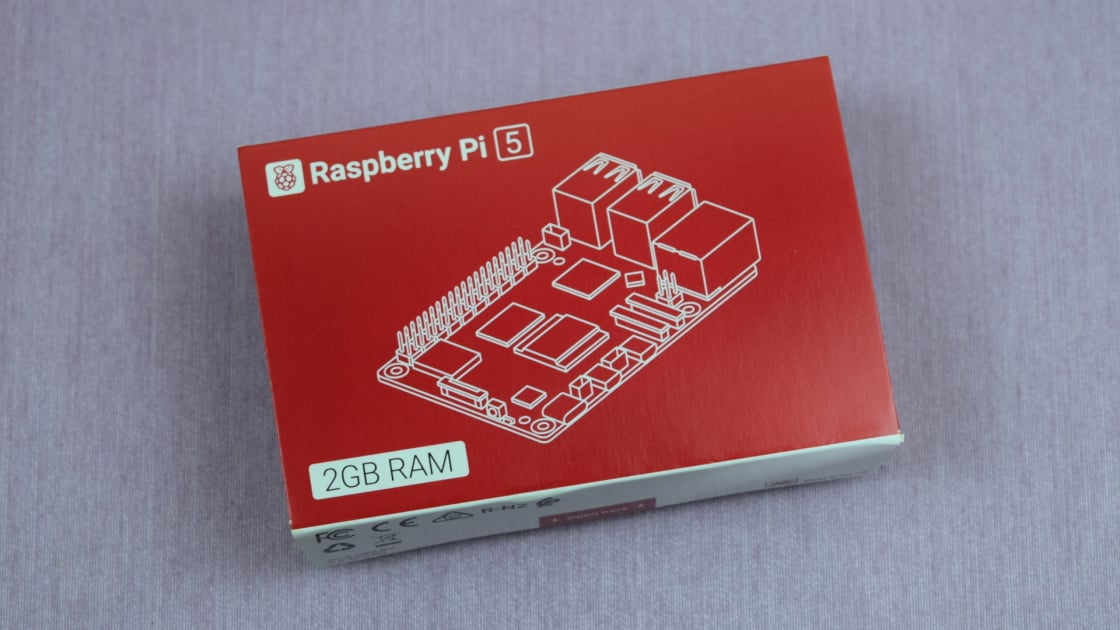
The original Raspberry Pi 5 is an exceptional little DIY desktop, but priced at $80, it’s also a bit more costly than some previous entries in the Pi family. For those seeking a more affordable Pi, the Raspberry Pi Foundation introduced a new version of the Raspberry Pi 5 that retails for $50 instead. The catch: Instead of featuring 8GB of LPDDR4X memory like the standard Raspberry Pi 5, this model ships with just 2GB of the same type of RAM. That’s quite the reduction, impacting performance about as much as expected. Still, this version of the Raspberry Pi 5 is undoubtedly a viable option for the right use cases—namely, driving mobile or low-power DIY computing projects.A Raspberry Pi 5 RecapThe Raspberry Pi 5 is the most potent single-board computer (SBC) that the Raspberry Pi Foundation has introduced to date, with several significant advantages over its predecessor, the Raspberry Pi 4 Model B. The primary processor on the Raspberry Pi 5 is a Broadcom BCM2712 system-on-chip (SoC) equipped with four Arm Cortex-A76 cores clocked at 2.4GHz. It also has more cache and a larger, higher-clocked VideoCore VII graphics unit, and it was produced on a more advanced 16nm manufacturing process.
Since 1982, PCMag has tested and rated thousands of products to help you make better buying decisions. See how we test.
(Credit: Michael Justin Allen Sexton)
Connectivity also improved on the Raspberry Pi 5, thanks to adding a secondary chip known as the RP1. This effectively functions as a southbridge in motherboard terminology and enables the Raspberry Pi 5 to support two USB 3.0 ports, a camera, and a DSI display connector. The system also supports a single PCIe 2.0 lane that can work as a high-speed SSD connection or support other hardware, such as AI accelerators like the Raspberry Pi AI Kit.
Long story short, the Raspberry Pi 5 is simply better than the Pi 4 in every way. It cost slightly more at launch, at $80 versus $75 for the Raspberry Pi 4. That said, the Pi 4 would have cost more if adjusted for inflation (it was released at that $75 price in 2020), so it’s hard to hold this against the Pi 5.
(Credit: Michael Justin Allen Sexton)
Even so, the Raspberry Pi 5 certainly isn’t the cheapest Pi device available. Depending on your intended use for the device, purchasing an older Raspberry Pi 4 or Pi 3 could make more sense instead of pulling the trigger on a new Pi 5. That’s where the latest Raspberry Pi 5 model with just 2GB of RAM comes in. It’s priced lower, at $50, putting it into more direct competition with older Raspberry Pi 4 and Raspberry Pi 3 devices.
(Credit: Michael Justin Allen Sexton)
The reduced RAM pool naturally impacts performance, but not as significantly as expected. The high-performance silicon is still here and clocked the same as on the standard Raspberry Pi 5, which means that the shortage of RAM only becomes problematic if you run too many applications or singular apps that are particularly memory-hungry.Testing the Raspberry Pi 5 (2GB): Measuring the Memory LossAfter setting up the Raspberry Pi with the latest version of the Raspberry Pi OS, I started testing the device by simply using it for everyday tasks. I used the Raspberry Pi 5 with 8GB of RAM a few times, including when I initially tested it, and I knew it could handle half-dozen tabs open on a web browser without any real issue.The Raspberry Pi 5 with 2GB of RAM struggled more with this, though, showing more significant slowdown as I opened more tabs. Running just two or three tabs open seemed to go OK on the default Chromium-based web browser, but the system became more sluggish with each additional tab I opened beyond that point. (My informal web browsing test primarily consisted of Google search pages, Wikipedia articles, PCMag, and CNN.)For more formal testing, I attempted to run all the benchmarks we did in our original Raspberry Pi 5 review but ran into some issues. After installing Pi Apps to make adding other applications easier, I installed the Geekbench 6 CPU benchmark and attempted to run it. This test would work initially, but it would stop running every time it tried to run the multi-threaded tests. At this point, midway through the testing run, it would suddenly display “Killed” in the terminal and stop the test every time. Without touching the system or any peripherals when this happened, and after attempting to run it multiple times, I gave up. I suspect the difference in RAM somehow threw the software off, causing it to fail halfway through the test.I also attempted to run the browser-based MotionMark graphics test, which also seemed not to work correctly. Instead of the 146-point score that the Raspberry Pi 5 with 8GB of RAM achieved, the 2GB model scored only 2 points. Though a performance drop would make sense due to the reduced amount of RAM, such a significant one suggests something else went wrong and threw off the test results.The browser-based SunSpider 1.0 test from BrowserBench.org worked without issue, giving results that make far more sense. It showed a modest performance drop for the Raspberry Pi 5 2GB compared with the 8GB model, with the 8GB model being slightly faster. At the same time, the Raspberry Pi 5 2GB was more than twice as fast as the Raspberry Pi 4 Model B with 8GB of RAM, which helps to demonstrate how much quicker the silicon that sits within the Pi 5 is, compared with its predecessor.
The only other test I could successfully run was an informal PPSSPP emulator test running a copy of MediEvil: Resurrection. I ran this game first with minimal settings, using no graphical enhancements and running at the PSP’s native resolution of 480 by 272 pixels. The game ran relatively smoothly in this configuration, maintaining around 57 frames per second (fps) during the game’s intro setting and 61fps while playing around in the first level.Next, I pushed the system hardware by enabling Bloom and FXAA as post-processing effects and doubling the resolution to 960 by 544. Naturally, this made the game look a lot better, but performance plummeted. With these settings, the game maintained around 43fps in the intro portion of the game, and 44fps in the first level. Performance in the first level was slightly better than what the Raspberry Pi 4 achieved, but it was far behind the 8GB version of the Raspberry Pi 5.Power Consumption Tests: Lower Power, Enhanced EfficiencyUsing a Kill-A-Watt wall meter, I measured the power consumption of the Raspberry Pi 5 2GB and the other tested Raspberry Pi models at idle and while running the PPSSPP emulator. Interestingly, the Raspberry Pi 5, with just 2GB of RAM, used considerably less power than the 8GB model. This isn’t so surprising, as it makes sense that the larger-capacity RAM modules would use more power. But I didn’t expect it to drop quite as much as it did.
At idle, the 2GB Raspberry Pi 5 consumed about two-thirds as much power as the 8GB model. This relative difference in power draw stayed about the same when both devices were placed under load, with the 2GB model seeing a one-third reduction in total power consumption compared with the 8GB model.This power reduction could be due to lower overall hardware utilization, as the lack of RAM keeps the CPU and GPU from running at their peaks. As the difference was relatively similar, however, it could all be down to the different RAM chip used on the 2GB model. Though both versions of the Raspberry Pi 5 use a single LPDDR4X memory module, the lower capacity of the memory module on the 2GB version means far fewer power-hungry transistors in the memory chip. We typically wouldn’t notice this sort of power difference from RAM, but due to the ultra-low power draw of these devices already, it comes into greater prominence. This may even give the 2GB model an advantage in areas where power consumption is critically important, like battery-powered devices.Verdict: Marked-Down Pi’s Still TastyDesigned as a tool for teaching software development, Raspberry Pi devices have been applied to a whole host of creative uses. Pi computers are found inside myriad custom-made computing devices, including numerous battery-powered ones. The 2GB Raspberry Pi 5 should work well for any of these purposes, as the amount of RAM tends to be less critical for specialized mobile computing tasks. As a bonus, the 2GB model’s improved energy efficiency, due to its lower memory capacity, makes it a better fit for battery-powered devices than the 8GB model.
(Credit: Michael Justin Allen Sexton)
The only place you’re likely to feel the difference in RAM is when using the 2GB Raspberry Pi 5 as a low-cost desktop, streaming device, or gaming system. In these situations, the lack of RAM becomes noticeable quickly, especially if you’ve previously used a Pi model with more RAM. For better results, we recommend sticking with the 8GB model if you plan to use the Raspberry Pi 5 for one of these purposes. But if you just want to learn to code, are implementing it into a battery-powered device, or are working up some other type of gadget that won’t use a lot of RAM, then the 2GB model is a very viable single-board-computing option.
The Bottom Line
The 2GB version of the Raspberry Pi 5 is highly affordable, with exceptional energy efficiency and performance that still outstrips that of the Pi 4.
Like What You’re Reading?
Sign up for Lab Report to get the latest reviews and top product advice delivered right to your inbox.
This newsletter may contain advertising, deals, or affiliate links. Subscribing to a newsletter indicates your consent to our Terms of Use and Privacy Policy. You may unsubscribe from the newsletters at any time.
About Michael Justin Allen Sexton
Analyst
For as long as I can remember, I’ve had love of all things tech, spurred on, in part, by a love of gaming. I began working on computers owned by immediate family members and relatives when I was around 10 years old. I’ve always sought to learn as much as possible about anything PC, leading to a well-rounded grasp on all things tech today. In my role at PCMag, I greatly enjoy the opportunity to share what I know.I wrote for the well-known tech site Tom’s Hardware for three years before I joined PCMag in 2018. In that time, I’ve reviewed desktops, PC cases, and motherboards as a freelancer, while also producing deals content for the site and its sibling ExtremeTech. Now, as a full-time PCMag analyst, I’m focusing on reviewing processors and graphics cards while dabbling in all other things PC-related.
Read Michael Justin Allen’s full bio
Read the latest from Michael Justin Allen Sexton






